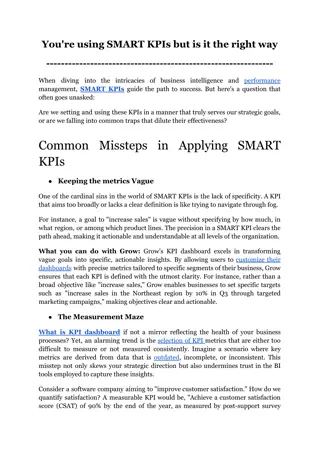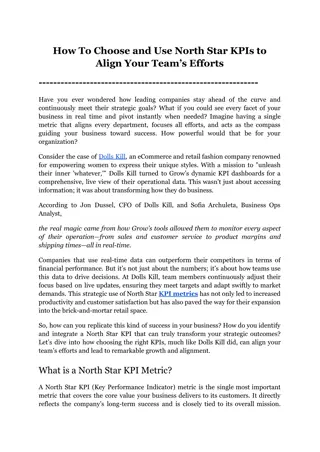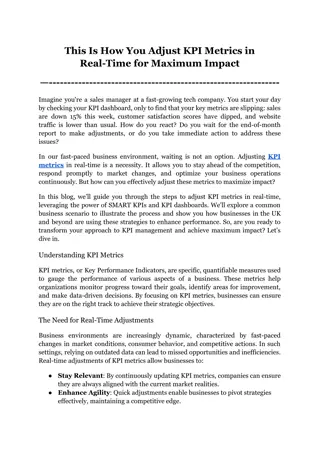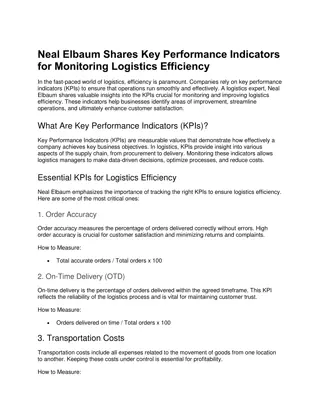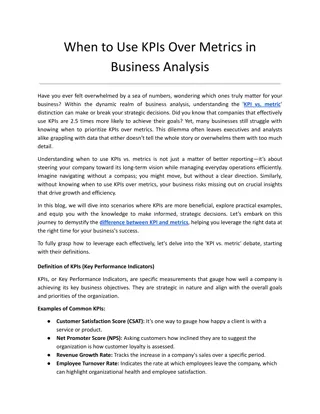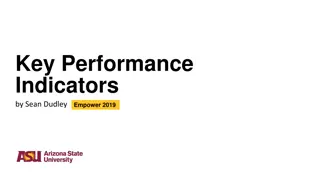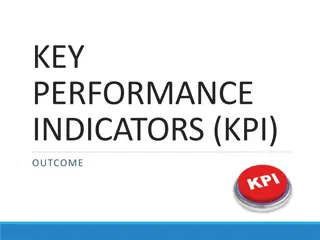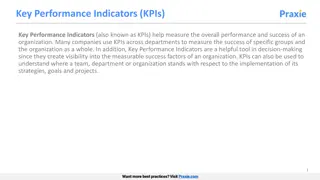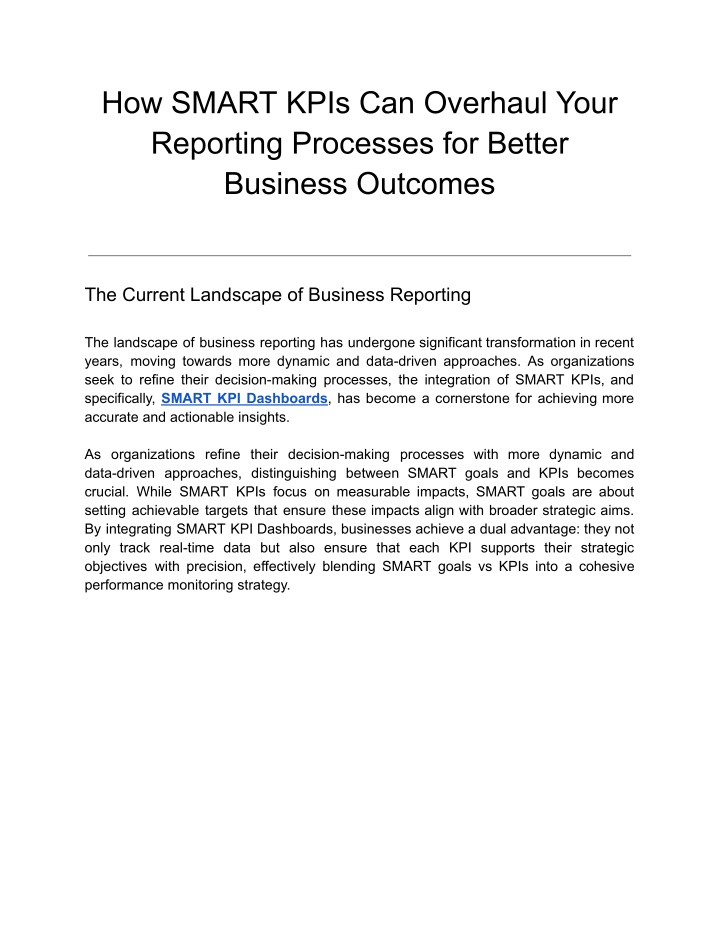
How SMART KPIs Can Overhaul Your Reporting Processes for Better Business Outcomes
Discover how SMART KPIsu2014Specific, Measurable, Achievable, Relevant, and Time-boundu2014can revolutionize your reporting processes, enhancing clarity and driving better business outcomes. This blog explores the transformative power of SMART KPI
Download Presentation

Please find below an Image/Link to download the presentation.
The content on the website is provided AS IS for your information and personal use only. It may not be sold, licensed, or shared on other websites without obtaining consent from the author. If you encounter any issues during the download, it is possible that the publisher has removed the file from their server.
You are allowed to download the files provided on this website for personal or commercial use, subject to the condition that they are used lawfully. All files are the property of their respective owners.
The content on the website is provided AS IS for your information and personal use only. It may not be sold, licensed, or shared on other websites without obtaining consent from the author.
E N D
Presentation Transcript
How SMART KPIs Can Overhaul Your Reporting Processes for Better Business Outcomes The Current Landscape of Business Reporting The landscape of business reporting has undergone significant transformation in recent years, moving towards more dynamic and data-driven approaches. As organizations seek to refine their decision-making processes, the integration of SMART KPIs, and specifically, SMART KPI Dashboards, has become a cornerstone for achieving more accurate and actionable insights. As organizations refine their decision-making processes with more dynamic and data-driven approaches, distinguishing between SMART goals and KPIs becomes crucial. While SMART KPIs focus on measurable impacts, SMART goals are about setting achievable targets that ensure these impacts align with broader strategic aims. By integrating SMART KPI Dashboards, businesses achieve a dual advantage: they not only track real-time data but also ensure that each KPI supports their strategic objectives with precision, effectively blending SMART goals vs KPIs into a cohesive performance monitoring strategy.
Traditionally, businesses relied on static reports generated at periodic intervals. Today, the demand for real-time data has led to the widespread adoption of interactive SMART KPI Dashboards, which provide continuous insights and foster an agile business environment. Businesses nowadays increasingly recognize the value of aligning their reporting processes with SMART goals (Specific, Time-bound). This alignment ensures that each KPI directly supports strategic objectives, enhancing the overall effectiveness of reporting systems. Measurable, Achievable, Relevant, Moreover, the introduction of advanced Business Intelligence (BI) platforms has revolutionized the way data is analyzed and reported. These platforms support the creation of SMART KPI Dashboards, enabling businesses to visualize complex data in an understandable and actionable format. Automation tools have also substantially reduced the time and effort required to generate reports, allowing for real-time data processing. This shift is crucial as it enables businesses to react promptly to market changes with data-backed decisions. The Anatomy of SMART KPIs
Specific: SMART KPIs are precisely defined, with clear parameters that eliminate ambiguity and ensure all team members have the same understanding and expectations. Measurable: Each SMART KPI must have a quantifiable metric to track progress effectively. This is where SMART KPI Dashboards play a crucial role, offering real-time data visualization that helps in monitoring these measurable outcomes. Achievable: SMART KPIs are set to be attainable; they challenge the team but are realistic enough to be achieved within the available resources and existing constraints. Relevant: These KPIs are aligned with the larger business objectives, ensuring that every metric has a direct impact on the company s strategic goals. Time-bound: By setting a clear deadline, SMART KPIs create a sense of urgency and help prioritize tasks, which is essential for maintaining momentum in business operations. Examples of Non-SMART vs. SMART KPIs in a Business Context Understanding the difference between non-SMART and SMART KPIs is critical for any organization aiming to leverage data effectively to drive strategic decisions. This section will dissect real-world examples to illustrate how transitioning to SMART KPIs those that are Specific, Measurable, Achievable, Relevant, and Time-bound can transform business reporting and outcomes, particularly when integrated with SMART KPI Dashboards. Common Pitfalls of Non-SMART KPIs Vague Targets: Non-SMART KPIs often suffer from lack of specificity. Example: "Increase sales." Without a specific target, it's difficult to gauge success or failure. Non-Measurable: Example: "Improve customer satisfaction." This KPI lacks a quantifiable metric, making it hard to track progress or achieve a tangible outcome. Unrealistic Goals: Setting goals that are out of reach can demotivate teams. An example would be to quadruple market share in just one month. Irrelevance: KPIs that do not align with the strategic goals of the company. Example: "Increase the number of pages on the website," which may not directly contribute to overall business growth. No Time Frame: Without a deadline, KPIs lack urgency. Example: "Launch the new product," with no set launch date. Transitioning to SMART KPIs
From Vague to Specific: Transform "Increase sales" to "Increase sales by 15% in the next quarter through online channels," making the KPI specific and tied to a clear strategy. Making It Measurable: Change "Improve customer satisfaction" to "Achieve a customer satisfaction score of 90% as measured by quarterly customer surveys." Setting Achievable Goals: Adjust "Double the market share within a month" to "Increase market share by 10% in the next six months through targeted marketing campaigns in three key regions." Ensuring Relevance: Instead of "Increase the number of pages on the website," use "Increase lead generation by 20% through enhanced SEO content on the top 10 product pages." Incorporating Time-Bound Elements: Specify "Launch the new product by Q3 2024, with pre-launch marketing starting two months prior." Leveraging SMART KPI Dashboards Visualization and Tracking: Utilizing SMART KPI Dashboards can help visualize progress towards these refined KPIs in real-time, enhancing the ability to make quick, data-driven decisions. Comparison of SMART goals vs KPIs: Dashboards allow for dynamic comparisons and deep dives into how SMART goals (specific objectives) align and differ from broader KPIs, providing actionable insights into operational effectiveness. How SMART KPIs Drive Better Business Outcomes Through Precise Targeting and Clarity Enhancing Decision-Making with Clarity Clarity in business objectives, through the lens of SMART KPIs, ensures that all stakeholders understand what is required and how success is measured, leading to more informed and faster decision processes. communication of KPIs ensures that every team member, from executives to front-line staff, understands their roles and responsibilities in achieving specific business outcomes. This level of understanding is critical in minimizing confusion and aligning efforts across departments. Clarity in the definition and In environments rich with data, clarity in KPIs helps in distilling complex information into digestible and actionable insights. SMART KPIs act as filters that highlight the most relevant data, allowing decision-makers to avoid data overload and focus on metrics that genuinely drive business progress. For instance, a clear KPI like "reduce production
costs by 5% within six months through improved supply chain efficiencies" directs attention to specific data points within the broader array of operational data. - Enhancing Accountability and Performance When employees understand how their actions contribute to clearly defined KPIs, accountability improves. Employee morale and output are both boosted by the clear link between individual efforts and the achievement of organizational objectives. For example, if a sales team is aware that their performance is measured by "increasing customer retention rates by 15% within the year," they are more likely to tailor their strategies and efforts to achieve this clear and measurable objective. - Supporting Long-Term Strategic Alignment More clarity in decision-making extends beyond immediate actions to support long-term strategic planning. Clear and relevant achievements are steps towards long-term goals, creating a sustained alignment that drives continuous improvement and innovation within the organization. SMART KPIs ensure that short-term The Role of SMART KPI Dashboards in Targeting - Centralizing Data Visualization SMART KPI Dashboards serve as centralized platforms where key performance indicators are visualized, making complex data accessible and understandable at a glance. By integrating data from various sources, these dashboards ensure that decision-makers have a holistic view of performance across all operational areas. For example, a SMART KPI Dashboard might display real-time data on customer acquisition costs alongside retention rates, providing a comprehensive view that aids in balancing resource allocation between marketing and customer service departments. - Enhancing Precision in Target Setting The precision of SMART KPI Dashboards lies in their ability to display data relevant to specific business goals, allowing managers to set targets that are not only ambitious but also aligned with company capabilities. The dashboards facilitate the breakdown of broad strategic objectives into actionable SMART goals KPI, enabling teams to focus their efforts on achievable targets that directly impact overall business success. - Facilitating Real-Time Adjustments
One of the key advantages of SMART KPI Dashboards is their ability to update data in real time. This feature is critical in today s fast-paced market environments, where conditions can change rapidly. For instance, if a dashboard indicates that the current campaign is not effectively reducing churn rate as per the SMART goals KPI, managers can immediately implement tactical changes to rectify the course. This agility in decision-making prevents minor setbacks from evolving into more significant issues. - Driving Strategic Alignment SMART KPI Dashboards help in aligning the day-to-day operations with long-term strategic goals. By consistently monitoring performance against SMART goals KPI, organizations can ensure that every department's efforts contribute towards the overarching business objectives. This alignment is crucial for maintaining strategic focus and coherence across various levels of the organization, fostering a culture of unified progression towards common targets. Conclusion Incorporating SMART KPIs into your business reporting processes is not just about tracking metrics; it s about transforming how your organization reaches its strategic goals with precision and clarity. By embracing SMART KPIs Specific, Measurable, Achievable, Relevant, and Time-bound you empower your team to make data-driven decisions that can significantly enhance productivity and efficiency across all levels of your organization. As we've explored in this discussion, the integration of SMART KPI Dashboards plays a pivotal role in this transformation, providing the tools necessary to visualize progress and adjust strategies in real time. Whether it s refining sales strategies, improving customer service, or optimizing operational efficiencies, SMART KPIs offer a clear path to not just meeting but exceeding your business objectives. For those ready to experience the power of advanced reporting and analytics, Grow offers an intuitive solution that brings these principles to life. Transform your data into actionable insights with Grow s comprehensive BI tools. We invite you to witness firsthand how Grow can revolutionize your reporting processes. Start your journey towards more informed decision-making with a 14-day free trial at Grow. Discover why businesses consistently rate Grow highly on platforms like Capterra Grow.com and see the difference it can make in your strategic planning and execution.
Don't let outdated reporting methods hold your business back. Try Grow today and start turning your data into your most valuable asset for achieving outstanding business outcomes. Original Source: https://bit.ly/3YCPJPc



